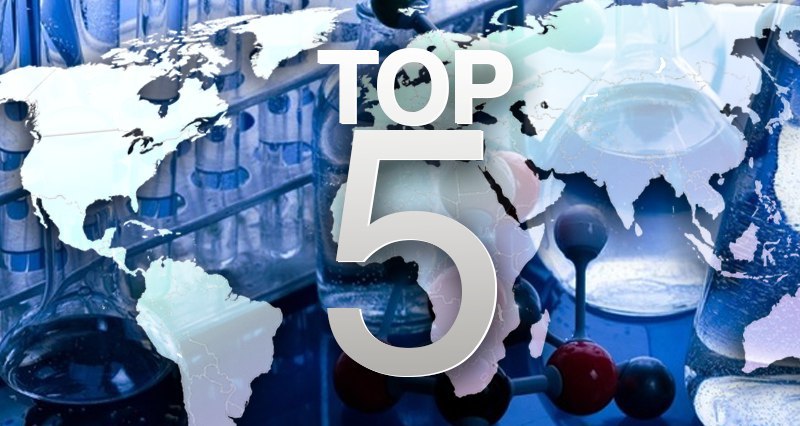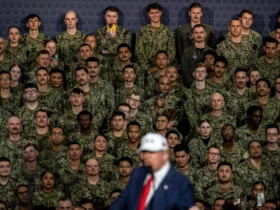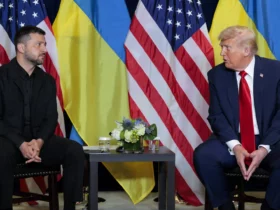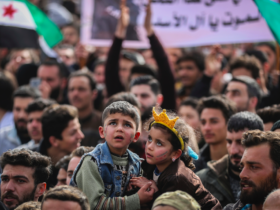The coronavirus pandemic has already claimed the lives of more than 170,000 people around the world. The US, Iran, China and Turkey, have suffered uncountable losses, however, the virus continues its victorious march around the world. It is expected that up to 2 million people will die within a year and almost the entire population of the earth will be affected.
In the US and China, theories about the artificial origin of the coronavirus are circulating. Some people think it was created in China, especially among the pro-Trump US media outlets. Others put forward strong arguments about the American origin of the coronavirus. However, whatever the cause of the pandemic is, the situation has raised awareness about the need to protect populations from biological warfare.
“The current pandemic foreshadows an even darker future, one for which we need to prepare. – Thomas G. Mahnken, an American military expert explains. Although it appears that COVID-19 is natural rather than man-made, that may not be the case the next time around. Indeed, our reaction to COVID-19 shows just how vulnerable we are to the hostile use of biological agents, and just how disruptive such an attack could be.
Despite that the virus seems to be man made, it has not stopped people from taking advantage of the situation. According to CNN: “The Justice Department has turned to biological warfare laws to bring two new cases against alleged coronavirus hoaxsters.”
Another interesting fact is that the Center for Health Security at Jons Hopkins Bloomberg School of Public Health has posted information about coronaviruses (including COVID-19) on its biological weapons page.
The effect of the coronavirus around the world has been a large proportion of the population unable to leave their homes, the economy experiencing widespread hardship and medical infrastructure all over the world being overwhelmed. All of this demonstrates the vulnerability of the world in the fight against biological weapons. Many states still possess serious stockpiles of biological weapons. We can not rule out the possibility that terrorists may one day gain access to such technologies. The question arises: which of the world’s countries are the most protected from this threat?
1. The US: an unstable hegemon.
The US is hegemonic power and the leader of the global West, a country with the world’s most powerful army and the largest defense budget in the world. Given the experience of the Cold War, when, together with the USSR, the United States accumulated the largest arsenal of biological weapons, one would think that the United States is best prepared to counter a biological attack.
However, the coronavirus pandemic has shown that this is far from the case. The United States now leads in COVID-19 cases, with about 830,000 people infected and 45, 500 deaths.
In 2018, the US published a new national Biodefense strategy. According to this document, federal biodefense activities are led by the U.S. Department of Health and Human Services (HHS). According to a study by the US Government Accountability Office (GAO) from June 2019, the US faces challenges related to defending against biological threats.
The First problem: there is “no existing mechanism across the federal government that could leverage threat information to direct resources and set budgetary priorities across all agencies for biodefense.”
Second problem: Situational and data integration – numerous federal agents and state authorities do not interact effectively enough with each other. The American bureaucracy has proved too cumbersome to adequately assess biological threats. In addition, it has been found that there are problems with the implementation of certain systems and programs responsible for early detection of biological threats.
Another problem is that the US disease laboratories themselves have been recognized as a threat to the health of US citizens. In 2008-2009, the GAO “found a proliferation of high-containment laboratories across the United States, with the number of such laboratories in the government, academia, and private sectors increasing since 2001.” Later, the GAO assessment showed that the safety measures in such laboratories were unsatisfactory. In March 2016, they found that most of the 8 departments and 15 agencies that were reviewed had policies that were not comprehensive or up to date. Among these agencies is the US Department of Defense.
It is interesting that independent experts use the security violation in a number of Ministry of Defense institutions to substantiate theories about the coronavirus having “leaked” from Fort Detrick, Maryland (U.S.A.M.R.I.I.D. Army Medical Research Institute of Infectious Diseases)
However, despite all these problems, the US still has a strong economy that could, if it wanted to, provide the necessary changes to build a more effective biological defense system.
The US Army Chemical Corps is responsible for biological protection.
There are limited details about how strong the military services in the United States, which are supposed to organize work to neutralize protection against highly dangerous infections, actually are. But relevant firms are already preparing the 2019-nCoV vaccine in the United States. Including those ordered by the Pentagon.
FOX News reports that “Gen. John Murray, Commander of Army Futures Command, recently told reporters that the service has already begun to look at new requirements related to the long-term combat effects of COVID-19.”
2. Russia: military excellence
Russia, despite its proximity to China, currently has only 60, 000 people infected by coronavirus and only 456 deaths. Against this background, Russia, like China, is actually helping other countries.
However, while China mainly sends equipment, artificial lung ventilation devices, medicines, masks to other countries, Russia has sent its own troops to Italy and Serbia with a few dozen disinfection machines.
Within the framework of the Russian Armed Forces, the Troops of Radiation, Chemical and Biological Protection are functioning – the successor of the Chemical Troops of the USSR. Their main task is disinfection of people and equipment, both military and civil.The Troops of Radiation, Chemical and Biological Protection are part of the unified system of civil protection of the country. This is also part of the heritage of the USSR.
Russia is coping with the coronavirus epidemic by civilian units, but the army is always ready to come to the rescue.
The Russian army has experience in fighting particularly dangerous infections. In the summer of 2016, the Russian army participated in the fight against the epidemic of anthrax in Yamal. In 2012, they fought anthrax in the Altai Territory. However, the largest epidemic of anthrax in Russia took place in Sverdlovsk (now Ekaterinburg) in April 1979. At that time about 100 people died from infected beef. According to one version, this was an act of sabotage enacted by American special services.
3. China: tested in Wuhan
Since the beginning of the Coronavirus epidemic, the Chinese People’s Liberation Army has been actively involved in eliminating the disease. In particular, it was reported that 1,400 military physicians of the Chinese Armed Forces were to treat patients with coronavirus in a specially built hospital in Wuhan within 10 days.
At the same time, Beijing reports that thanks to early measures taken, not a single case of coronavirus in the People’s Liberation Army of China was identified. Chinese President Xi Jinping, who has entrusted the army medical brigades with the most difficult duties, says that the virus is now “largely contained” thanks to their efforts.
Personnel from the PLA Academy of Military Medical Sciences have many years of experience, including dealing with the problems of SARS, Ebola and the earthquake that devastated Sichuan in 2008. This research center is analogous to the American Fort Detrick, i.e. the main defense center engaged in disease control and protection against bacteriological weapons.
In mid-February, Chinese leadership ordered an additional 2,600 troops to fight the Coronavirus epidemic. It was fortunate that in 2016 the joint logistic support headquarters was established in Wuhan, which made it possible to quickly launch the fight against coronavirus from the military side.
Now, the PLA Ground Force has 13 brigades of engineering and Chemical and Biological Defense defense forces.
In 2002-03, the Chinese military successfully participated in the liquidation of the SARS. In 2019, the Chinese team took first place in all the competitions of the crews of radiation, chemical and biological reconnaissance “Safe Environment” within the framework of the Army International Games 2019 held in China. Teams from Armenia, Egypt, Russia and Vietnam also took part in the competition. The Russian team took second place, and third place was won by Vietnam.
4. Iran: ready for biological warfare
In March, IRGC Ground Force Commander, Brigadier General Mohammad Pakpur, stated that an order had been issued to deploy military units in areas where coronavirus is prevalent.
Special teams of the SC IRGC also carried out urban disinfection in Gilyan, Kermanshah, Qom and Tehran provinces. In addition, a “biological headquarters” was established within the armed forces to fight the coronavirus.
It is worth mentioning that in March, against the background of the epidemic, the Islamic Revolutionary Guard Corps (IRGC) launched biological defense exercises throughout the country in coordination with the headquarters of the National Coronavirus Campaign in accordance with the policy of the General Headquarters of the Iranian Armed Forces in 3000 regions of the country and 100 points in Tehran, the capital city, with the participation of IRGC ground forces and Basij militia units.
Thus Iran demonstrated that it has a functioning system of bio-defense that can be applied in an emergency. No other country in the Middle East besides Israel has such a complex system.
The Iranian Army has also conducted major national exercises to improve its preparedness in the face of biological threats to the country as the coronavirus spreads. The army’s bio-defense exercises were held in line with the decree of the Supreme Leader of the Islamic Revolution, Ayatollah Seyed Ali Khamenei, in which he warned that the outbreak could be the result of a “biological attack” against the Islamic Republic.
Iran, despite the sanctions, is actively working on biological protection issues for fear of an Israeli and American biological attack. In particular, back in 2016, the country’s military industry presented its own radio biochemical reconnaissance vehicle Shahram. The car was built on the basis of the Soviet armored personnel carrier BTR-60.
5. Great Britain: not a “global leader”
Britain is home to Porton Down, the world’s first chemical weapons installation set up in 1916. It is the place where biological toxins and germs are stored to develop “effective countermeasures to the constantly evolving threat posed by chemical and biological weapons.” In 2018, the UK presented its “Biological Security Strategy” where it described itself as “a global leader in biological sciences”, arguing it has the ‘opportunity to demonstrate our expertise and be at the forefront of work to meet these challenges.’
The British strategy is largely based on preventive measures, and includes active intelligence work to assess natural and man-made biological threats and work abroad to stop sources of the disease. At the same time, the UK response to the Coronavirus epidemic demonstrates that the authorities have failed to anticipate or provide an adequate response to the threat. (https://www.gov.uk/government/news/the-truth-about-porton-down

















Leave a Reply